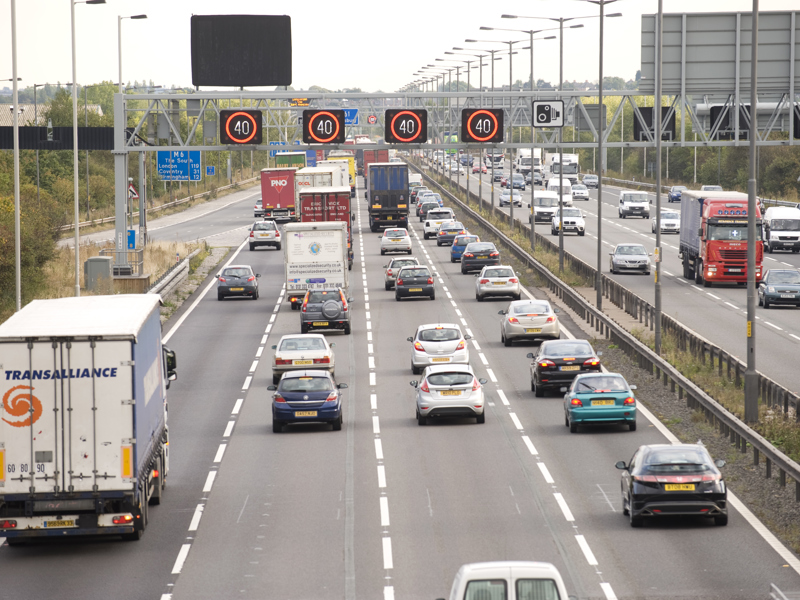What does data mean for infrastructure? Its resilience and availability can be improved. Standards of service can be raised, from smoother roads to on-time faster trains. These can be provided in the right capacity for a good quality of life, making efficient use of funds invested and minimising environmental impacts.
Data and Infrastructure
Data is not an end in itself. We are capturing ever increasing quantities of data describing the state, condition and usage of infrastructure. Simply reviewing measurement data is not particularly rewarding. The benefits depend on using data to do things differently for better results.
Driving on motorways you will be aware of variable message signs. Variable speed limits prevent congestion and keep traffic moving. This data-led, increasingly automated approach improves safety and performance.
On the railways, service reliability is influenced by management decisions that are increasingly informed by data – from changes to staff shift patterns, to subtle timetable adjustments. Data and modelling give rail managers dependable insights into the best steps to resolve repeat issues.
The national infrastructure increasingly includes fleets of delivery vehicles for services such as online shopping. Fleet operators are using data in new ways to improve planning and management based on accurate forecasts and optimised in real-time to react efficiently to shifts in demand.
Improving decisions by building data into the decision-making process is a key development, not only for new digital services, but also to optimise core maintenance regimes. A good example is the Forth Road Bridge, a critical artery for the Scottish economy, which has avoided prolonged closures since Amey introduced a sensor-enhanced maintenance regime in 2018.
The ability to capture and record data in large volumes, and to process and circulate data at low cost, is a game changer for infrastructure. However, the popular label “Industry 4.0” suggests an illusion of inevitability around the benefits, which masks several common pitfalls.
Pitfalls
Data strategies often disappoint. In 2019, a Gartner analyst estimated that 85% of big data projects fail to deliver business value.
Yes, the availability of data in infrastructure has exploded. For commercial data, long trapped in transactional systems, possibilities are being unlocked by emerging open data standards and adoption of analytics-ready data lakes. Meanwhile, the internet of things is becoming a reality. However, investment in data capture will only generate benefits when it is tied to actions. Our aim is not to use data for its own sake, but to make infrastructure services better.
Forecasting (or “predictive analytics”) often appears top of the data-innovation list. Knowledge of the future should enable optimal planning. However, access to lots of data is no guarantee of practical benefits. Suppose we produce a more accurate forecast of rail passenger numbers. A marginal gain in forecast accuracy may not alter how trains on fixed timetables are best operated. Delivering benefits from data requires knowledge of operational processes that can respond to data for maximum reward at minimum cost. In the rail example, rather than forecasting, if data is used to assess the impact of tactical actions at stations, this can be used to improve daily decision-making in response to operational disruption. No level of artificial intelligence brilliance will substitute for properly understanding the business levers that can improve outcomes.
Decision Science
Delivering benefits requires more than just technically expert developers. An intense focus on the technical data problems creates research projects that are disconnected from the day-to-day. Decisions and actions are key, otherwise data solutions risk achieving little.
Figure 2 - Decision-making patterns with different use of data
a) Aware of information
b) Research workflow
c) Active performance optimisation
Amey benefits from a century of experience of operational infrastructure, so our data scientists are quick to focus in on the decision points where data solutions can make a real-world difference. We call this decision science.
There are still no guarantees data solutions will be technically successful. The capacity to manage experimentation and investment risk is vital. Figure 3 illustrates the combination we see as critical, bringing business understanding, together with technical data expertise and a framework for managing investment risk. Some great ideas will surpass expectations, while others will fail. Each data initiative involves a technical hypothesis which will be valid in some cases and not in others.
Figure 3 – Features of data-led transformation programmes that deliver results
Data-led transformation programmes should be broad in scope. The areas of greatest benefit can be uncovered through a process of exploration. Rather than pre-supposing that a specific innovation will succeed, we adapt agile practices to deliver results fast in new applications of decision science (see Figure 4).
The innovation funnel requires critical attention to a set of success factors. In staged innovations we repeatedly test against these criteria. We need to assess the clarity with which the business problem and solution approach are understood, and whether the required data is available.
People considerations are equally important. We review the level of support from senior stakeholders in the organisation, and the availability of subject matter experts. In our experience, when innovation is prioritised on this holistic basis, we maximise time spent on projects that deliver results.
Figure 4 – An innovation funnel tests the widest set of ideas while targeting investment to deliver maximum value
Society is set to redouble its focus on investing in the right infrastructure for the future. Significant investment brings opportunities along with risk of wastage. But brilliant advances can be made, when we bring a focus on the role of data in decision-making to tackle the important practical problems in infrastructure.
